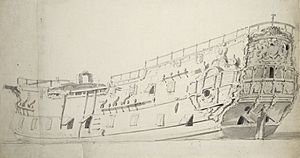HMS Dartmouth (1655) facts for kids

A fifth-rate warship being refitted sketched by Willem van de Velde the Younger, believed to be Dartmouth
|
|
Quick facts for kids History |
|
|---|---|
| Name | HMS Dartmouth |
| Ordered | 28 December 1654 |
| Builder | Portsmouth Dockyard |
| Cost | £1,693-5-0d |
| Launched | 22 September 1655 |
| Commissioned | 1655 |
| Fate | Wrecked 9 October 1690 |
| General characteristics | |
| Class and type | 22-gun fifth-rate frigate |
| Tons burthen | 260.7 tons bm |
| Length | 80 ft (24.4 m) (keel) |
| Beam | 24 ft 9 in (7.5 m) |
| Depth of hold | 10 ft (3.0 m) |
| Propulsion | Sails |
| Sail plan | Full-rigged ship |
| Armament |
|
HMS Dartmouth was a small but important warship. It was a type of ship called a frigate, which was fast and used for scouting or protecting other ships. It was also known as a fifth-rate ship, meaning it was a medium-sized warship with a certain number of guns. The English government ordered six ships like Dartmouth in 1654, and this one was built in 1655.
Contents
Building a Warship: The Design of HMS Dartmouth
HMS Dartmouth was built at Portsmouth Historic Dockyard. The person in charge of building ships there was John Tippetts. He was a Master Shipwright, which means he was a very skilled shipbuilder. Tippetts had learned how to build ships in Denmark.
He used special Dutch shipbuilding methods. These methods made ships strong and efficient. Dartmouth is the only known English ship from that time built using these Dutch techniques.
Battles and Adventures: HMS Dartmouth's Service
Fighting the Dutch: Anglo-Dutch Wars
HMS Dartmouth saw action in several big wars. In April 1666, during the Second Anglo-Dutch War, Dartmouth teamed up with two other English ships. They were the larger frigate HMS Sapphire and the smaller Little Gift. Together, they captured three Dutch merchant ships that were armed off the coast of Ireland.
Later, on May 28, 1672, Dartmouth was part of a major sea battle. This was the Battle of Solebay, which was the first big fight of the Third Anglo-Dutch War.
Chasing Pirates: Against the Barbary Pirates
From 1676 to 1677, Dartmouth sailed to the Mediterranean Sea. Its mission was to fight against the Barbary Pirates. These pirates were based in places like Tripoli and Algiers. Dartmouth was part of a group of ships led by Rear Admiral John Narborough. Their job was to protect trade ships and stop the pirates.
Supporting the King: Williamite-Jacobite Wars
By 1689, Dartmouth had more guns, now carrying 36. On May 1, 1689, it fought in the Battle of Bantry Bay. In this battle, 19 English warships faced 24 French warships. The French ships were helping Irish forces who supported King James II. The French ships damaged the English ships, but they didn't follow up on their advantage.
Later that same year, Dartmouth played a very important role. It helped to end the Siege of Derry. The city of Derry (also called Londonderry) in northern Ireland was surrounded by supporters of King James II. The people inside the city supported King William.
Derry is located on the River Foyle, which flows into Lough Foyle. Ships could reach the city by sailing up the river.
In May and June 1689, Dartmouth helped escort a group of ships from England. These ships carried soldiers and supplies to help Derry. The convoy left Liverpool with 24 transport ships and three warships, including Dartmouth. They arrived in Lough Foyle in early June.
The river leading to Derry was blocked by shore batteries and a large boom across the water. The English commander, Major-General Percy Kirke, was worried about attacking. However, a brave attempt was made on July 28. Dartmouth fired at the shore batteries to distract them. Meanwhile, an armed merchant ship called Mountjoy crashed through the boom. Mountjoy and another ship, the Phoenix, then sailed past the defenses into Derry. This brave action relieved the siege and saved the city.
The Final Voyage: Wreck of HMS Dartmouth
In 1690, Dartmouth was working off the west coast of Scotland. It was trying to get Scottish clans, like the MacLeans of Duart, to support King William III and Queen Mary II. On October 9, Dartmouth and two smaller ships were sailing up the Sound of Mull. A terrible storm hit, and they anchored to try and survive the bad weather.
However, Dartmouth's anchor cables broke. The ship was pushed onto rocks and wrecked. Most of its crew, including the commanding officer, Edward Pottinger, were lost.
Finding the Wreck: Discovery of HMS Dartmouth
In 1973, divers from Bristol found a shipwreck. It was on the north coast of an island called Eilean Rudha an Ridire, in the Sound of Mull. They found a brass bell, which confirmed it was the wreck of HMS Dartmouth.
For three years, archaeologists studied the wreck. They found twenty iron guns and parts of the ship's hull. They also recovered many items from the 17th century. These included military gear, navigation tools, medical supplies, and everyday items. The study showed that parts of Dartmouth's construction were unique.
Because of its importance, the wreck site was one of the first to be protected by law. This happened on April 11, 1974, under the Protection of Wrecks Act 1973. It was protected again in 1992 and became a Historic Maritime Protected Area in 2013.
Images for kids



